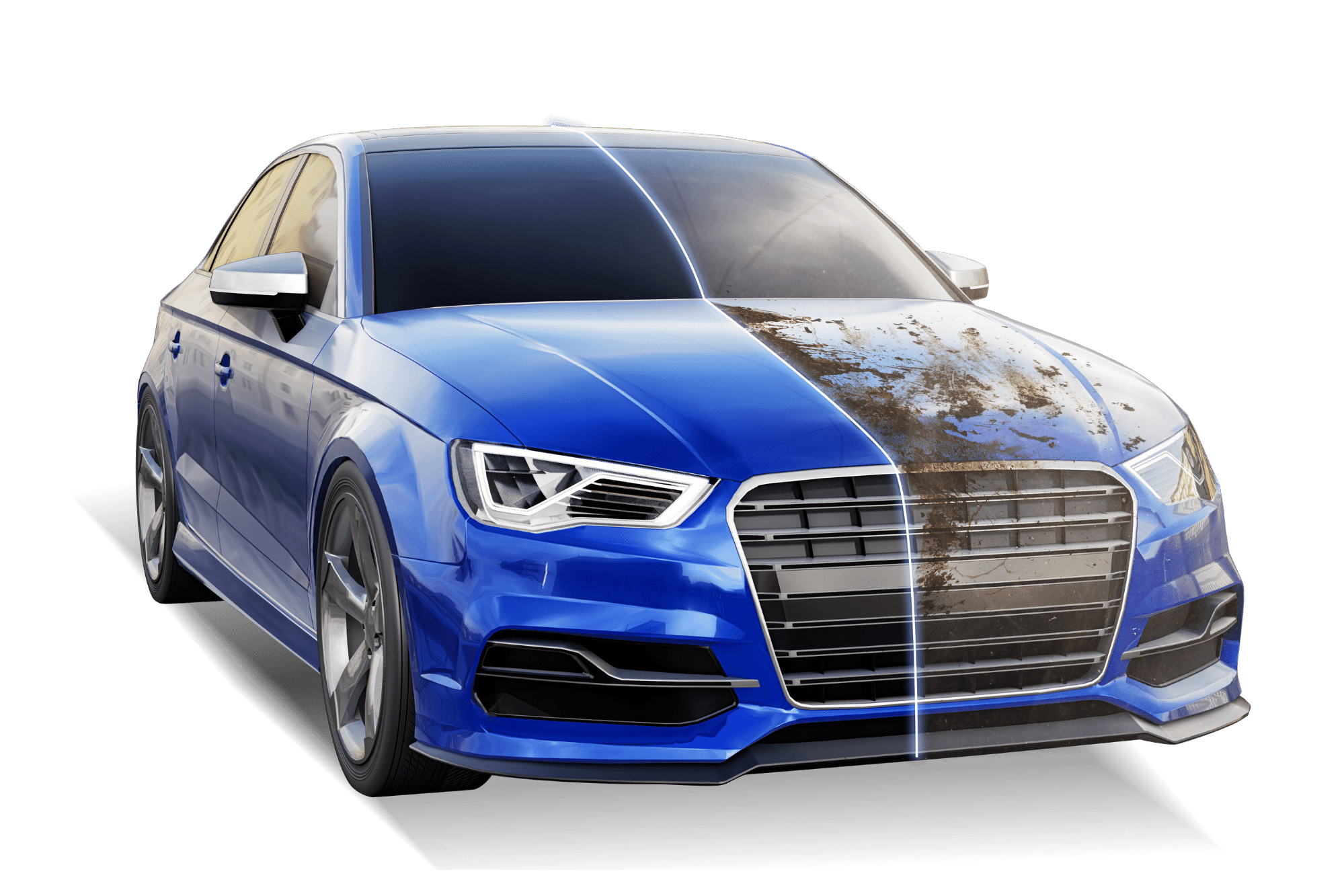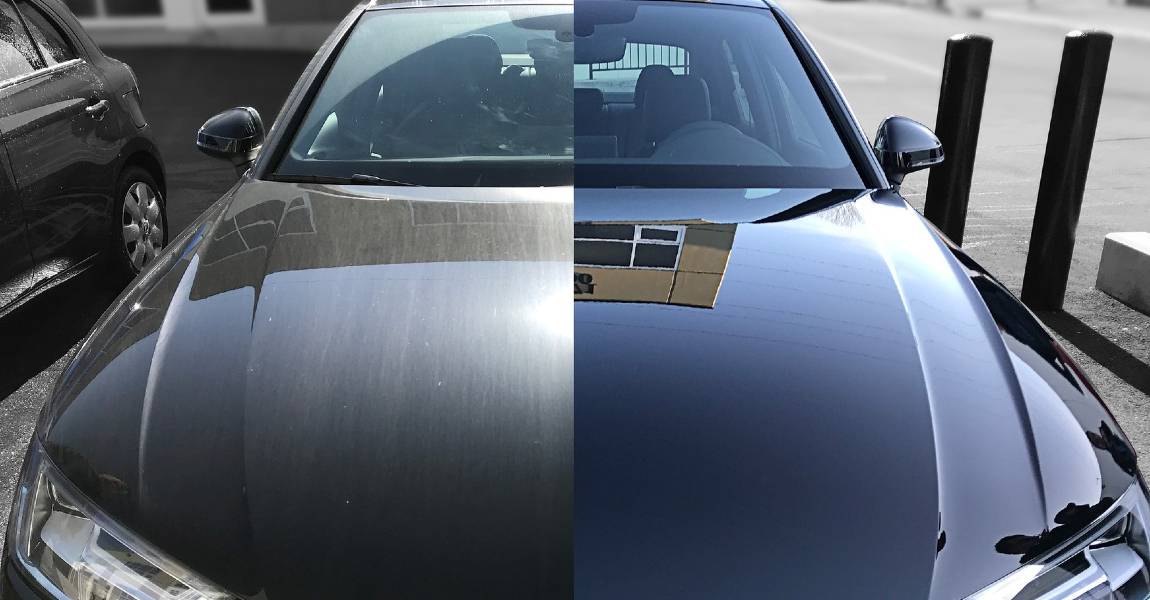Checking out the Science Behind Car Ceramic Coating and Its Protective Features
The scientific research of car ceramic coating offers a fascinating study in innovative auto security. Made up primarily of silicon dioxide and polymers, these finishings develop a durable bond with lorry paint. This interaction improves sturdiness against ecological risks while supplying hydrophobic benefits. Nevertheless, the intricacies of how these finishes work and their long-term advantages continue to be much less understood. Unpacking these information discloses why ceramic coatings are ending up being a recommended option for car care
What Is Ceramic Coating?
Ceramic coating is a liquid polymer that chemically bonds to the surface of a car's paint. This sophisticated protective layer boosts toughness and supplies premium resistance to ecological variables. Unlike conventional wax or sealants, which provide short-lived security, ceramic layers produce a long-lasting shield that can stand up to extreme conditions such as UV rays, acidic impurities, and extreme weather. When applied correctly, the coating creates a hydrophobic surface, causing water to grain and slide off, which assists in preserving the vehicle's cleanliness. Furthermore, it uses boosted gloss and deepness to the paint, making the vehicle appear more sleek and dynamic. The application procedure usually involves detailed surface prep work, consisting of cleansing and sprucing up, to guarantee peak bonding. As an outcome, ceramic coverings are coming to be progressively preferred among car enthusiasts and those looking for to safeguard their financial investments, promising to preserve the lorry's aesthetic allure while reducing the regularity of upkeep.
The Make-up of Ceramic Coatings
The detailed solution of ceramic layers mostly is composed of silicon dioxide (SiO2), which is obtained from all-natural resources like quartz and sand. This essential component supplies the structure for the coating's sturdiness and safety top qualities. In addition to SiO2, ceramic finishes frequently consist of different polymers and additives that enhance attachment, versatility, and resistance to ecological elements. These substances function synergistically to create a durable obstacle against pollutants such as dust, chemicals, and UV rays.Furthermore, some solutions integrate titanium dioxide (TiO2) or other nanomaterials, which can augment the coating's hydrophobic buildings, causing improved water repellency. The precise composition can differ substantially amongst suppliers, influencing efficiency and durability. Eventually, the mix of these components finishes in a safety layer that not just boosts the visual appeal of cars yet additionally offers to extend their life expectancy by securing the surface from possible damages.
Exactly How Ceramic Coatings Work
Comprehending how ceramic coverings work involves exploring their chemical composition, which adds to their safety qualities. The application procedure is essential for attaining excellent outcomes, while longevity and sturdiness aspects identify the coating's effectiveness with time. With each other, these elements highlight the advantages and efficiency of ceramic finishes for car protection.
Chemical Make-up Explained
While lots of car proprietors look for resilient protection for their lorries, the chemical structure of ceramic finishings plays a vital function in their efficiency. These coverings largely consist of silicon dioxide (SiO2), which is stemmed from all-natural minerals. This compound develops a solid bond with the vehicle's paint, creating a long lasting, protective layer. Furthermore, lots of ceramic coatings include titanium dioxide (TiO2), improving their hydrophobic residential or commercial properties and resistance to UV rays. The existence of polysiloxanes can even more improve adaptability and sturdiness. With each other, these aspects add to the coating's ability to push back water, dust, and contaminants, while likewise giving a high-gloss surface. Recognizing this chemical foundation assists car proprietors value the robust security offered by ceramic finishes.
Application Refine Introduction
Applying ceramic coverings involves a thorough process that guarantees optimal bonding and defense for the vehicle's surface. At first, detailed cleansing and decontamination of the car's outside are executed to get rid of dirt, grime, and previous waxes. This step verifies that the surface area is without pollutants that could prevent bond. Following this, the paint is typically polished to boost quality and remove any imperfections. Once prepared, the ceramic coating is applied in small areas using an applicator pad, enabling consistent insurance coverage. The coating my response is after that delegated heal, creating a solid chemical bond with the surface area. Proper treating times and conditions are important, as they verify the coating achieves its maximum effectiveness and safety high qualities.
Long Life and Longevity Elements
Ceramic coatings are created to provide resilient defense via their innovative chemical structure, which produces a robust obstacle against ecological contaminants. The resilience of these finishes is affected by aspects such as the thickness of the application, the high quality of the item, and the problems under which the car is revealed. High-grade ceramic finishes can last several years, standing up to scrapes, UV rays, and chemical stains. Correct maintenance, consisting of routine cleaning and regular reapplication, can better improve longevity. In addition, environmental factors like climate and exposure to toxins can impact the life-span of the coating. In general, when used and kept appropriately, ceramic finishes supply exceptional durability, making them a prominent choice for car fanatics seeking to protect their vehicle's appearance.
Hydrophobic Residences and Water Repellency
Hydrophobic residential properties are a hallmark of top quality car ceramic coverings, substantially enhancing the car's surface area efficiency. These layers create a molecular bond with the car's paint, resulting in a surface area that pushes back water efficiently. When water comes into call with a ceramic-coated surface, it beads up and rolls off, lessening the quantity of fluid that continues to be on the paint. This behavior not only adds to a visually pleasing appearance yet likewise minimizes the build-up of contaminants such as dust, gunk, and roadway salts.The enhanced water repellency leads to less complicated cleaning and upkeep, as much less initiative is called for to eliminate undesirable substances. On top of that, the hydrophobic nature of ceramic finishings aids in protecting against water areas, which can mar the finish of uncoated surface areas. Generally, the consolidation of hydrophobic residential properties in ceramic finishings plays a vital role in preserving the automobile's beautiful appearance while streamlining maintenance.
Defense Versus Scratches and UV Damage
Car ceramic coverings offer substantial protection versus scratches and UV damages. The scratch resistance device creates a sturdy layer that absorbs effects, while the UV shielding advantages help keep the car's paint honesty over time. With each other, these features contribute to a longer-lasting and visually enticing surface.
Scratch Resistance Device
Utilizing advanced innovation, ceramic finishings offer a robust guard against scrapes and UV damages, improving the durability and appearance of automobile surfaces. The scrape resistance system of these finishings is credited to their unique molecular framework, which forms a long lasting bond with the lorry's paint. This bond produces a hard, safety layer that can absorb influences and withstand abrasions. In addition, the smooth surface of the coating reduces friction, making it hard for contaminants to stick and cause scrapes. The chemical composition of ceramic finishings usually includes nanoparticles that enhance the safety layer, more enhancing its durability. As a result, vehicles treated with ceramic finishes show considerably enhanced scratch resistance contrasted to traditional wax or sealants, making sure a beautiful surface with time.
UV Shielding Perks
The protective qualities of ceramic finishes extend beyond scratch resistance to include considerable UV securing advantages. These coatings produce a robust obstacle that mirrors dangerous ultraviolet rays, guarding the vehicle's paint and underlying products. Prolonged exposure to UV radiation can cause fading, oxidation, and damage of the paint surface. By incorporating ceramic layers, vehicle proprietors can successfully mitigate these threats, protecting the aesthetic appeal and honesty of their automobiles. In addition, the UV obstructing properties add to enhanced durability, reducing the frequency of repainting and maintenance. Eventually, the assimilation of ceramic finishes offers an extensive service for safeguarding vehicles from the destructive results of look at this website sun direct exposure, making certain a sustained, dynamic appearance gradually.
The Long life and Upkeep of Ceramic Coatings

Often Asked Concerns
Can Porcelain Coating Be Applied to Any Type Of Type of Vehicle?
Ceramic coating can be put on numerous sorts of vehicles, consisting of cars, vehicles, and motorcycles. Nonetheless, surface prep work and compatibility with particular products are vital for optimal adhesion and efficiency of the coating.
Just How Much Does Ceramic Coating Generally Price?
Ceramic coating commonly costs between $500 and $2,000, depending upon elements such as lorry size, coating high quality, and professional application. The financial investment can provide long-lasting defense and boost the automobile's look gradually.

Is Professional Application Needed for Finest Outcomes?
The need of professional application typically depends upon desired outcomes. Specialists commonly guarantee proper surface area preparation and application strategies, resulting in perfect bonding and durability of the coating, which might be testing for inexperienced individuals to accomplish.
Can Porcelain Coatings Be Eliminated or Fixed?
Ceramic layers can be eliminated or fixed, though the procedure might call for certain solvents or strategies - Ceramic Coating Newark. Proper removal is crucial to prevent damages to the underlying surface area, stressing the value of expert help for optimal results
How Does Porcelain Coating Compare to Typical Wax?
The comparison between ceramic coating and typical wax reveals that ceramic coverings use superior toughness, improved security versus environmental pollutants, and longer-lasting sparkle, while wax needs a lot more frequent application and provides less general resistance to damages.